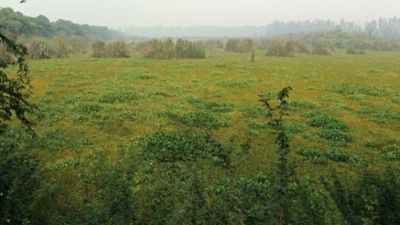- News
- City News
- gurgaon News
- Haryana: In search of migratory flocks & cleaner air, just 2 hours away
Haryana: In search of migratory flocks & cleaner air, just 2 hours away

Located in Jhajjar district, the Bhindawas Bird Sanctuary covers an area of 412 hectares (approximately 1,019 acres)
It’s that time of year when a few hours out in the country can bring blessed relief. But, while you leave behind the smog of the city for Bhindawas Bird Sanctuary, you still won’t be able to escape the haze, a film of which hangs suspended in the air, leaving the sun looking a little sickly. This, though, has less to do with any farm fire or factory pollutants than the meteorological phenomenon called humidity.
Located in Jhajjar district, and sandwiched among the villages of Sahjanpur, Kanwah, Niwada, Reduwas, Chadwana and Bilochpura, the sanctuary covers an area of 412 hectares (approximately 1,019 acres). The board at the park’s entrance says that 265 species have been spotted here, birds that come either to roost or rest, or visitors from the frigid north in search of the coldweather sunshine.
But, it’s a late autumn day, the afternoon sun still warm on our backs, and still some time before the migrant birds arrive for their winter sojourn. Yet, we could easily spot resident species such as the egret, cormorant and francolin. Others were more elusive, only their calls indicating their presence, calls that vied with the shrieks of monkeys and the bleats of herders’ sheep.
A 12km track that rims the sanctuary is long enough to make for a bracing walk, especially on a chilly December morning.
From the entry gate, the track heads straight until turning into an L-shape, at which point is sited a watchtower that’s seen better days but gives the birder a decent prospect of the surrounding geography, of the marshy land, reeds, tiny islands, and, of course, the avian species lording it on their home patch (or the visitors making the most of their flight south).
Bhindawas is actually a manmade freshwater lake, the biggest in the state. Declared a protected area in the mid-1980s, it was designated an eco-sensitive zone by the Ministry of Environment, Forests and Climate Change, in 2011. And only last year, in the summer of 2021, this wetland became a Ramsar site, giving it a slightly higher profile (even though it already had protected status).
If you have the patience (and the season is right), you’ll have little problem spotting the fesser flamingo, bar-headed goose, painted stork, black-necked stork, and the francolin — of the latter, the black variety too, which just happens to be the state bird of Haryana. Ducks and coots are plenty visible, as are waders (sandpiper, moorhen) and raptors (marsh harrier, different species of eagle).
The sanctuary supports species now recognised as key in the global conservation effort, among them the mallard and red-crested pochard. Endangered species such as the Egyptian vulture, and vulnerable species including the common pochard have also been sighted in the wetland. Interestingly, according to the Ramsar website, Bhindawas supports 1.7% of the biogeographic population of the greylag goose, and more than 2% of the biogeographic population of the Indian cormorant. Besides acting as a natural flood buffer, the wetland in Bhindawas also aids in recharging the groundwater, to better maintain the region’s water table and ecological balance.
Of course, threats to its wellbeing remain, including weeds — infestation of which chokes the water channel here —and fluctuating water levels. A few weeks from now will be the ideal moment to head to the Bhindawas Bird Sanctuary (a drive of just under two hours from Gurgaon), when the migrating flocks join the home birds to start up a symphony, and offer us more than a glimpse of nature’s magic — at least until March, when spring rolls around again.
Located in Jhajjar district, and sandwiched among the villages of Sahjanpur, Kanwah, Niwada, Reduwas, Chadwana and Bilochpura, the sanctuary covers an area of 412 hectares (approximately 1,019 acres). The board at the park’s entrance says that 265 species have been spotted here, birds that come either to roost or rest, or visitors from the frigid north in search of the coldweather sunshine.
But, it’s a late autumn day, the afternoon sun still warm on our backs, and still some time before the migrant birds arrive for their winter sojourn. Yet, we could easily spot resident species such as the egret, cormorant and francolin. Others were more elusive, only their calls indicating their presence, calls that vied with the shrieks of monkeys and the bleats of herders’ sheep.
A 12km track that rims the sanctuary is long enough to make for a bracing walk, especially on a chilly December morning.
From the entry gate, the track heads straight until turning into an L-shape, at which point is sited a watchtower that’s seen better days but gives the birder a decent prospect of the surrounding geography, of the marshy land, reeds, tiny islands, and, of course, the avian species lording it on their home patch (or the visitors making the most of their flight south).
Bhindawas is actually a manmade freshwater lake, the biggest in the state. Declared a protected area in the mid-1980s, it was designated an eco-sensitive zone by the Ministry of Environment, Forests and Climate Change, in 2011. And only last year, in the summer of 2021, this wetland became a Ramsar site, giving it a slightly higher profile (even though it already had protected status).
If you have the patience (and the season is right), you’ll have little problem spotting the fesser flamingo, bar-headed goose, painted stork, black-necked stork, and the francolin — of the latter, the black variety too, which just happens to be the state bird of Haryana. Ducks and coots are plenty visible, as are waders (sandpiper, moorhen) and raptors (marsh harrier, different species of eagle).
The sanctuary supports species now recognised as key in the global conservation effort, among them the mallard and red-crested pochard. Endangered species such as the Egyptian vulture, and vulnerable species including the common pochard have also been sighted in the wetland. Interestingly, according to the Ramsar website, Bhindawas supports 1.7% of the biogeographic population of the greylag goose, and more than 2% of the biogeographic population of the Indian cormorant. Besides acting as a natural flood buffer, the wetland in Bhindawas also aids in recharging the groundwater, to better maintain the region’s water table and ecological balance.
Of course, threats to its wellbeing remain, including weeds — infestation of which chokes the water channel here —and fluctuating water levels. A few weeks from now will be the ideal moment to head to the Bhindawas Bird Sanctuary (a drive of just under two hours from Gurgaon), when the migrating flocks join the home birds to start up a symphony, and offer us more than a glimpse of nature’s magic — at least until March, when spring rolls around again.
FOLLOW US ON SOCIAL MEDIA
FacebookTwitterInstagramKOO APPYOUTUBE
Start a Conversation
end of article









